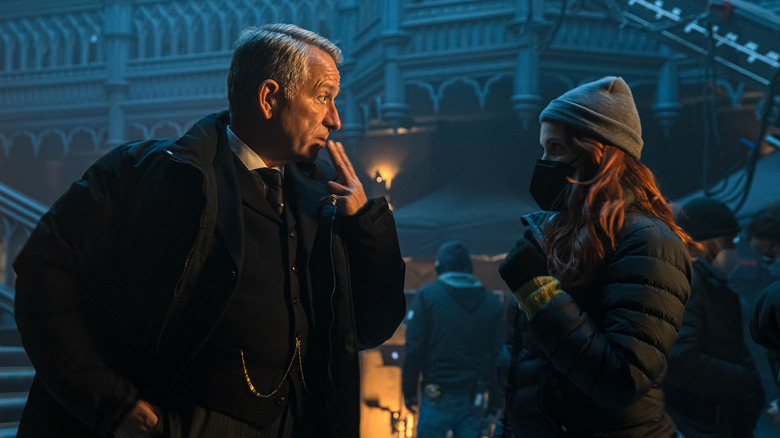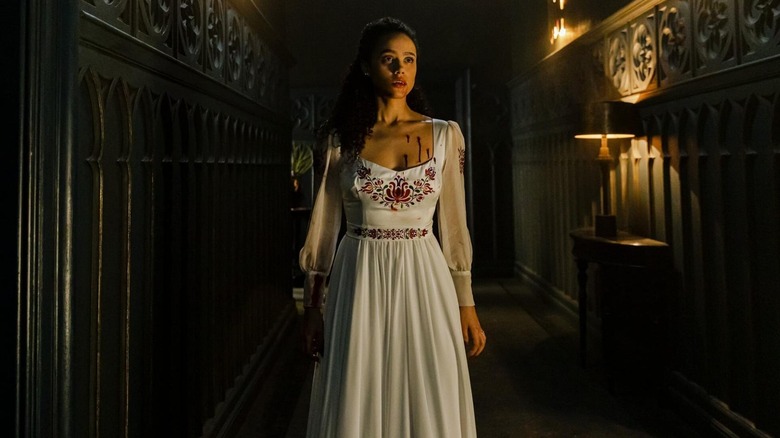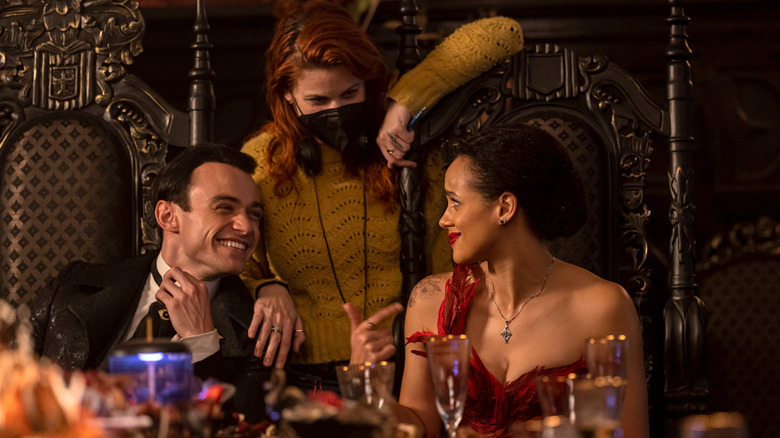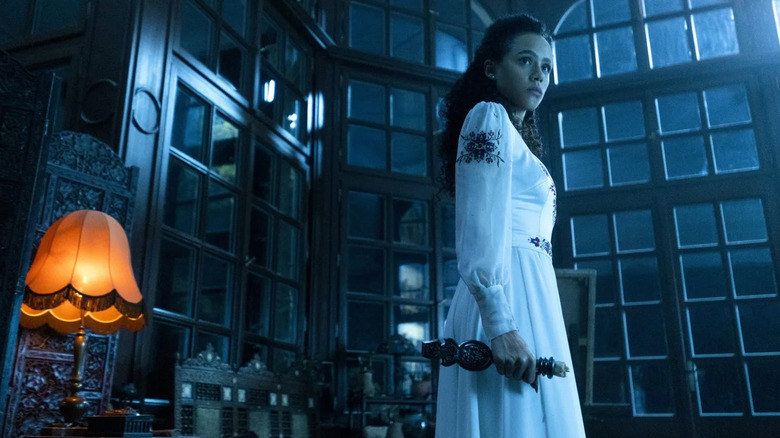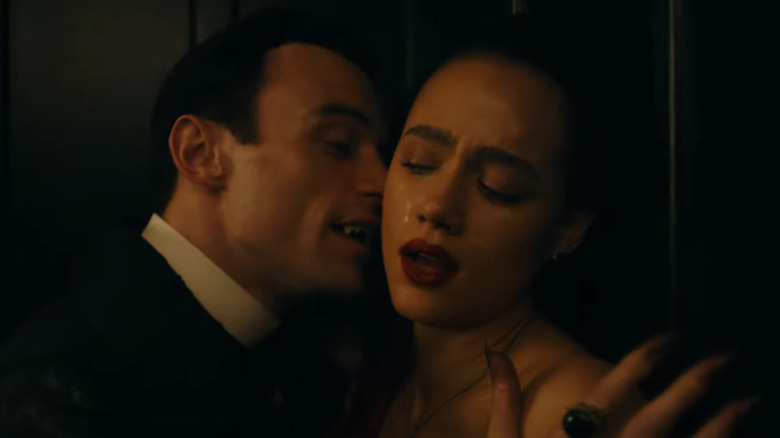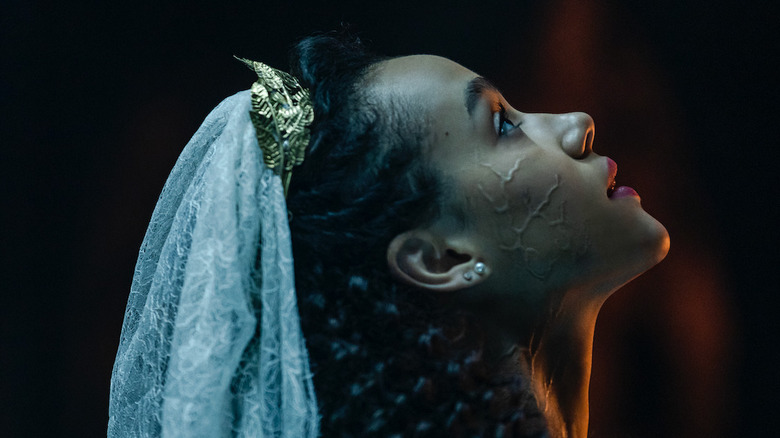'The Invitation' Director Jessica M. Thompson Talks Dracula Easter Eggs, Practical Fang Challenges & More [Exclusive Interview]
In order to prepare for "The Invitation," in theaters now, director Jessica M. Thompson watched "every single vampire film ever made." The co-writer and director behind the horror film, which was originally titled "The Bride," uses elements from past horror lore to tell a more modern vampire tale. The story follows Evie (Nathalie Emmanuel) as she discovers a long lost family of filthy rich bloodsuckers. In other words, it's "Downton Stabby," an online joke Thompson appreciated.
Prior to "The Invitation," Thompson directed "The Light of the Moon" and six episodes of "The End," plus worked on "The Handmaiden's Tale" as an apprentice director. The director's latest film is a refreshingly handcrafted piece of studio horror with minimal CG. As Thompson told us, the more grounded and real, the scarier the effect. In our interview with Thompson, we talked about the dozens of vampire and horror Easter eggs throughout, the practicalities of vampire fangs, cutting the movie for a PG-13 rating, and much more.
'They're not just nods to Dracula. Some of them are nods to some of my favorite horror films.'
Are there 90 Easter eggs from "Dracula" in the movie?
Well, there's over 90, but it's close to 90. Yep, lots of little Easter eggs in there for the hardcore fans, anyone who wants to go through and find them all.
Have you noticed anyone already picking up on the real deep cuts?
Yes. Some people have messaged me about things that I did not expect them to pick up just from the trailer alone. They're not just nods to "Dracula." Some of them are nods to some of my favorite horror films. So for instance, the wallpaper and the floor of the hall are from "The Shining," the same pattern as the carpet. So some people have noticed that, my little nods to Kubrick. I've got a nod to Tony Scott from "The Hunger," which is one of my favorite vampire films, so I've included little nods. I always love doing that and to pay homage to the greats.
You're the second filmmaker I've heard recently to mention Tony Scott's "The Hunger" as an influence.
It's so overlooked. It's not really considered in one of the top vampire films, but it's actually sumptuous and delightful. Who doesn't want to watch David Bowie and Susan Sarandon all day?
It's a great movie. Anything about the tone or mood about "Dracula," in particular, you wanted to reflect?
To be honest, I haven't read the book since I was 12. I feel like it was mandatory reading in grade seven or something like that. So it's funny the things that I thought were in the book that were absolutely not in the book, just because since then you've watched "Interview with the Vampire" and "True Blood" and "Twilight" and whatever else, and you start to forget what is actually in the source novel. So for instance, I went back to some of the original ideas that Bram Stoker had, which was that the vampires can walk around during the day. They don't burn from the sun, it's just that they lose their powers. To me, I wanted to go back to stay true to some of those ideas, but still make a modern contemporary film, so I wanted to keep both parties happy.
But that being said, I actually, upon second reading before making the film, I realized how sexist Bram Stoker is. Wildly. Throughout the whole book, he calls any woman who has slight opinions, she's a "new woman," which must have been their term for a feminist, I suppose. If any woman has a thought of her own, they're like, "Oh, new woman these days." So I decided there's a line in the film from Victoria, where she says, "She's all sparkly and new," which is my little nod to Bram Stoker's problematic positioning on something.
So that's one of the deep cuts.
Yes, that's one of the deep ones. That's one that I think very few people will pick up on.
'There are so many films that I love that have giant potholes'
Even though audiences have seen plenty of vampire stories by now, how much do you feel like you have to explain the rules?
It's hard to find that balance, because to me, I am always someone who will lean towards subtlety and lean away from over-explaining. I think audiences are extremely smart these days. But then, of course, in post[-production], you add a few lines because you realize that something's not quite landing, because people don't know the rules as much as you think. I forget that people don't consume horror as much as I do.
Sometimes you get a reminder that, "Okay, you are not making this film in a vacuum. You're not making it for yourself. You're making it for an audience and you want them to be entertained and understand as well what's happening." But that being said, I've also thought I don't think we need to hit people over the head with logic. If they're enjoying the film and they're emotionally involved, and quite often, there are so many films that I love that have giant potholes, but they're still fantastic because you're there with the characters.
I couldn't agree more. A lot of those YouTube videos now, it's just like, "It's a movie."
Yeah. I'm sure if I was to break down "Everything Everywhere All at Once," which is my favorite film of this year, I'm sure I would find a lot of holes in the logic and whatever, but I don't care because the story is just phenomenal, and the directing is 10 out of 10. As long as you stay true to what the story is, then the audience will be with you.
With that in mind, for you, how'd you want to stay true to the story here?
To me, it's about a young woman who's an artist, and she's recently lost her mom, and she's craving human connection. She does this DNA test, and she finds out about it. So to me, a lot of her decisions are about wanting to connect with humans, wanting to feel love and connection. Of course, that ends up going awry. But what I love is that with Evie's story, I don't want to give it away, but she becomes the monster to kill, but [in order] to vanquish the monster. She goes back to her heritage. It's her mom's voice in her head that gives her the strength to do that. So to me, it was all about that. Staying true to yourself is really the emotional arc that I wanted to stick with.
'To me, perfect characters are boring'
It's difficult to be likable, but Nathalie is really likable as Evie.
Oh, she's wonderful. She's such an empathic human being. She just puts her all into everything. She really wants to understand her characters. But I also like that sometimes she pushes back when she's like, "There's no need to be snarky about it," and she talks back to people. She can be a little, we say bolshy, I don't know what Americans say. She can be a little feisty, feisty. Bolshy means feisty, I think.
Right, just because they're nice doesn't mean they're weak.
Exactly. I wanted to create a fully rounded character. To me, perfect characters are boring, so I wanted to make sure she had some complexities.
How were you and your cinematographer responding to her on the day? Any qualities you wanted to visually capture or emphasize?
I always wanted to be with her. I think you probably noticed that we're always a little bit closer to her. Some lenses can really obscure someone. So for instance, once the penny drops, we started to use really wide angle lenses for closeups, and that creates a bit of distortion. We made sure when we're with Evie at the start that we didn't do any of that, so we made sure that we felt like the audience would feel a connection with her. But really, to me, it was more about making sure when we were in the nightmare world versus the fairytale world.
So for the lighting, for the design and things like that, making sure that contrast was always there, and we knew which one we were leaning towards, because I didn't want us to feel, even though we know there are moments, we were like, "Get out. It's gone too far." I didn't want us to feel like her staying was completely unbelievable or anything like that, because she is falling in love, and these [people] are her family, and so she thinks there's an easy way to justify some things. So that's definitely the way that we shot it, where I think it helps us go on her journey.
The "Outlander" shirt went a long way to explain why'd she'd go.
Oh, good. I'm so glad, because a lot of people have asked me specifically, "What were you trying to say?" Oh, I was like, "I think it's pretty obvious that this is a woman who believes in romance," but also I wanted to [feature] a series that's about going back in time, and she feels like she's almost stepped back in time when she walks into this world. So I'm glad that you think it doesn't need to be explained, because I don't think so either. It's also because during the pandemic, that was one of the things that I binged and I was like, "Oh, I'll give a little nod to that."
'The person who built it was the great, great grandson of Madam Báthory, who was The Blood Queen, who swam in the blood of virgins'
Was the exterior of the house ever a model? When you first see it, it has this unreal quality to it.
They were real. That's a real location. Yeah, an 18th century castle that we found in Hungary. The person who built it was the great, great grandson of Madam Báthory, who was The Blood Queen, who swam in the blood of virgins. When I found that, one, I loved the castle. As we were walking up to it, I was like, "This place is surreal. This looks exactly what I imagined." Then when somebody told me that it was Báthory's great, great grandson, I was like, "Okay, we have to film here. This is it." But all the exteriors and a lot of the interiors, the rehearsal dinner scene, the room with the family reunion, those are all real rooms in that castle. Then we built the great hall and Evie's bedroom and things like that, so it's a mixture. It's both real and created,
I'm surprised there hasn't been a great, big, epic horror movie made about her yet.
Now it's like, "Well, then maybe that'll be the next one." I will say I wanted to sleep in this castle. It's just so crazy. When else do you get an opportunity? Then when I saw this painting of her just staring at me, I was like, "Maybe not."
What was it, an original painting there still?
I think a recreation of a painting of her, but it's one of those paintings where her eyes follow you. We never used that room. It was too regal. It was like a courtroom almost, I want to say, where people met and talked about law. I don't know. It was all these big portraits and she was one of them. I was like, "Eh, this is a bit too creepy for me."
Too creepy for the movie?
Yeah. Too creepy. I don't know about that woman. She's going to come and haunt me.
[Laughs] How'd you and your production designer want to create a sense of family history in the house?
Well, to me, these people would been alive for hundreds of years, if not thousands. So it's the artifacts that they would collect throughout time. If you notice a lot of the paintings are, for instance, the abduction of the Sabine woman that we put in paintings, in sculptures that were usually about men oppressing women, basically, we thought that would be very subtle. I don't think anyone's picked up on them yet, but that's the art that he is drawn to, and I wanted a mixture of new and old. For instance, all the light fixtures in the house are extremely modern or even postmodern, very much contemporary. Me and Felicity [Abbott], the production designer, we specifically picked out specific vases, specific paintings. So the vase that she uses at the end to hurt someone, it's an old Chinese painting that depicts men dragging women along. So we tried to put that all in the artifacts, because we figured that's the world he likes and that he's created.
'We laid in a kookaburra over a lizard and morphed it, and that's how we came up with the unique vampire sound'
For lack of a better term, what'd you want out of the vampire noises?
Well, a big thing was in Bram Stoker's was that he kept describing them in a very lizard reptilian way, so [my first note] that I gave to my sound designers was using reptiles, using geckos noises, but it still sounded a bit alien, like the actual movie "Alien." It actually had this futuristic quality to it that I didn't like. Then, this is a secret, I think you're the first person to hear it, we used a kookaburra.
No kidding?
Yeah. We laid in a kookaburra over a lizard and morphed it, and that's how we came up with the unique vampire sound. It was actually one of our sound mixers who found it and he's like, "Look, it's your country bird." I was like, let's do it.
What about the vampire aesthetic? What qualities were important for you and the team?
Well, with our brides, I wanted them to stay true to the era that they were turned in. Lucy was turned in the 1920s, Victoria was turned 500 years ago, so therefore their fashion, their hair, their makeup, all of that, so there were very subtle details about what they wear and how they wear their character.
But in terms of the prosthetics and everything we tested, no, I wanted it to not be a traditional, just two fangs. Originally I had four, well, two on the top and two on the bottom, but the actors couldn't speak. They all had lisps, which is, it's just really hard when you get so used to feeling your teeth the way they feel to relearn how to speak. You'd need probably months, which we didn't have. So that's why we use the top two, the two on each side. That still was a challenge.
I actually made the actors wear them during the day just when they were not on set so they could learn how to speak with them in their mouth. But all of that stuff needs to be done well in advance, and you need to figure out as well, when you think of that rehearsal dinner scene. There are so many shots where they are pre-vampire and post-vampire, so you have to be able to take them out quickly as well. That's another thing, with the claws and things like that. Not only are you designing something that looks realistic and that looks authentic, you've got to also think practicalities. You've got to be able to pop in and out, so it's not just the level of detail, it's also functionality, which is really interesting.
I never thought about that before, but now that you mention it, how tricky it must be to deliver lines with fangs.
Thomas [Doherty] found it the hardest. There was a couple of lines that we had to ADR later, because it's hard. I tried them myself just to see, and it's quite difficult. There are some words, if you've just gotten used to with S or TH or PH, they're hard to say.
Before you ADR-ed it, was it like a horror comedy?
Yes, exactly. I was like, "Oh, Dracula's got a lisp." I was like, "I don't think that the people will appreciate that," but that's what's magic about modern filmmaking, as well. you can go back in [and fix it]. I'm like, "Just stay in your character. Don't worry about it. Don't think about it because we'll fix it later."
'We are releasing the R version online later'
The movie is PG-13, right?
It is, but we are releasing the R version online later.
What are the main differences between the two cuts?
There's more gore, there's more blood in the R version. There is more swearing, and there is the sex scene is five times longer. So these are the things that you have to pull back for PG-13, but it's really interesting. I think it opens your audience up. I love PG-13 horror films; like "A Quiet Place," I thought was fantastic. There was no way anyone could tell me that's not a scary, terrifying film, even without blood and gore. It was interesting to not have to rely on those devices to keep people in suspense, but I think it's rated well. I think it's fantastic that my nieces and nephews, who are 13 and 15, get to go with their mums and dads, so that's cool. I love an R-rated horror film too, don't get me wrong. The right amount of gore and the right amount of blood is also something that I admire.
Did you shoot with a rating in mind?
You shoot with the rating in mind. Otherwise, it'll change.
What did you want with the vampires' physicality? You don't rely too much on CG or ridiculous acts of strength.
I'm glad that you picked up on that, because to me, as soon as something's so super human and so super powerful, I lose interest in it, personally. If you literally have the ability to fly and punch through walls and things like that, then it doesn't make it a real challenge. It's just, you're so outweighed.
The reason I mention "The Shining" a lot is because it is my favorite horror film. I think what's so scary about it is that it's someone who you love and trust that's turning against you. To me, if that person is supernatural, that doesn't have as much impact. I wanted them be slightly stronger and slightly faster, but not to the point where it's impossible for her to vanquish them because otherwise, it takes out the tension.
It was finding that right balance of doing tricks rather than relying on the effects, using special effects in camera tricks that can show that little bit of strength, that super human strength, but not go to the point of relying on the effects. A lot of them are practical effects that we shot in camera for that reason, because I wanted it to feel grounded and realistic.
That's great to hear, because CGI is just not scary 99% of the time.
I agree. I think I love Guillermo del Toro and I worship the ground he walks on, partly because of his prosthetics, it's phenomenal. I think I love that about the '80s horror films, like "The Thing" and "The Fly," because those were done practically, and that actually makes it far scarier.
"The Invitation" is now playing in theaters.
